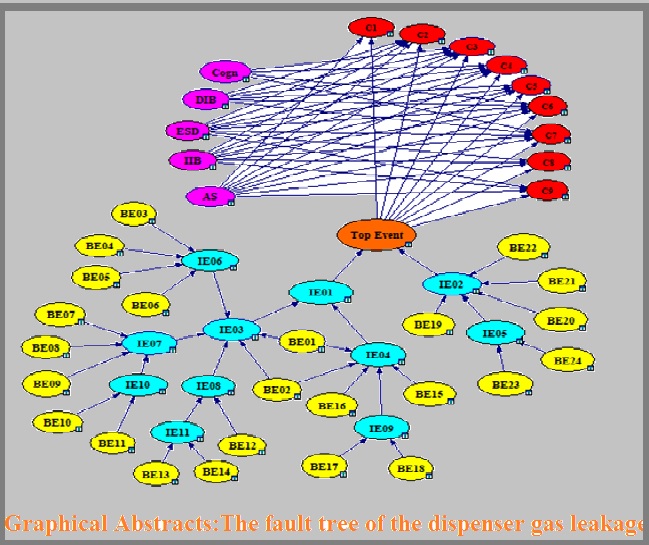Volume 9, Issue 4 (12-2019)
J Health Saf Work 2019, 9(4): 250-264 |
Back to browse issues page
Download citation:
BibTeX | RIS | EndNote | Medlars | ProCite | Reference Manager | RefWorks
Send citation to:



BibTeX | RIS | EndNote | Medlars | ProCite | Reference Manager | RefWorks
Send citation to:
Eskandari T, Mohammadfam I, Mirzaei Aliabadi M. Dynamic Safety Analysis CNG Stations Using Fault Tree Approach and Bayesian Network. J Health Saf Work 2019; 9 (4) :250-264
URL: http://jhsw.tums.ac.ir/article-1-6212-en.html
URL: http://jhsw.tums.ac.ir/article-1-6212-en.html
1- Department of Occupational Health Engineering, Occupational Health and Safety Research Center, School of Public Health, Hamadan University of Medical Sciences, Hamadan, Iran
2- Department of Health, Safety and Environment Management, Occupational Health and Safety Research Center, School of Public Health, Hamadan University of Medical Sciences, Hamadan, Iran. ,mohammadfam@umsha.ac.ir
3- Department of Health, Safety and Environment Management, Occupational Health and Safety Research Center, School of Public Health, Hamadan University of Medical Sciences, Hamadan, Iran.
2- Department of Health, Safety and Environment Management, Occupational Health and Safety Research Center, School of Public Health, Hamadan University of Medical Sciences, Hamadan, Iran. ,
3- Department of Health, Safety and Environment Management, Occupational Health and Safety Research Center, School of Public Health, Hamadan University of Medical Sciences, Hamadan, Iran.
Abstract: (4023 Views)
Introduction: The safety of CNG stations is important because of their location in urban areas, as well as to prevent accidents and to protect the safety of personnel, property, and environment. An event occurrence analysis with probability updating is the key to dynamic safety analysis.
Methods and materials: In this study, the Failure Modes and Effects Analysis (FMEA) technique was used to determine the hazards of the study unit, the method of analyzing. After determining the hazards with high risk, the Bayesian fault tree analysis (BFTA) method was used to determine the effective causes of events occurrence and the type of possible relationships among them.
Results: First, the phase of hazards identification, 16 Hazardous equipment were identified. Then the Risk Priority Number for the identified equipment was calculated. The results showed that the dispenser system had the highest risk priority number and was identified as the most critical equipment. According to this, the dispenser gas leakage (as the top event) was selected in this study. Then, the analysis of the dispenser gas leakage, using BFTA method identified 56 main causes, including 17 intermediate events and 39 basic events. Finally, cracking and corrosion of the dispenser hose were determined the most effective factor in the occurrence of the top event. The probability of occurrence of the top event based on FTA and BFTA analysis was calculated 9.67×10-2 and 9.11 × 10-2, respectively.
Conclusion: The result of the study that by employing the Bayesian Network, can create a useful guideline to determine the relationship between the occurrence causes of the top event. This provides an assessment of the effectiveness of preventive measures before using them.
Methods and materials: In this study, the Failure Modes and Effects Analysis (FMEA) technique was used to determine the hazards of the study unit, the method of analyzing. After determining the hazards with high risk, the Bayesian fault tree analysis (BFTA) method was used to determine the effective causes of events occurrence and the type of possible relationships among them.
Results: First, the phase of hazards identification, 16 Hazardous equipment were identified. Then the Risk Priority Number for the identified equipment was calculated. The results showed that the dispenser system had the highest risk priority number and was identified as the most critical equipment. According to this, the dispenser gas leakage (as the top event) was selected in this study. Then, the analysis of the dispenser gas leakage, using BFTA method identified 56 main causes, including 17 intermediate events and 39 basic events. Finally, cracking and corrosion of the dispenser hose were determined the most effective factor in the occurrence of the top event. The probability of occurrence of the top event based on FTA and BFTA analysis was calculated 9.67×10-2 and 9.11 × 10-2, respectively.
Conclusion: The result of the study that by employing the Bayesian Network, can create a useful guideline to determine the relationship between the occurrence causes of the top event. This provides an assessment of the effectiveness of preventive measures before using them.
Type of Study: Research |
Received: 2019/12/28 | Accepted: 2019/12/28 | Published: 2019/12/28
Received: 2019/12/28 | Accepted: 2019/12/28 | Published: 2019/12/28
Send email to the article author
| Rights and permissions | |
 |
This work is licensed under a Creative Commons Attribution-NonCommercial 4.0 International License. |






